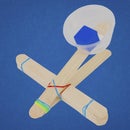Introduction: Crash Test Cars
We've all heard of the classic egg-drop engineering challenge, so here's a twist: crash test race cars! The students in my extracurricular engineering class love this project because of its open-ended nature and thrilling process. You can find the lesson plan, 1-page project sheet, and more project ideas at STEM-Inventions.com
Materials:
I made an Engineering Creation Kit that has everything you need for this project and many more, or buy parts individually below. This is just a suggested list of materials and you're invited to come up with your own additions. You can make the project more or less challenging by changing the materials provided. For example, including large 12oz plastic cups and cotton balls would make it extremely easy to build a cushioned enclosure. In the photo above uses pieces of straw for cushioning and a rubber band for a seatbelt.
- 2.5" Plastic eggs
- Coins or washers (for adding weight to the egg)
- 4-1/2" Craft sticks
- 1/2" Craft cubes (Bulk pack)
- 1/8" dowels
- Small plastic wheels
- 2oz plastic portion cup
- Masking tape
- Hot glue gun with safety nozzle
- Hot glue sticks
Step 1: Crash Test Cars
More footage of crash tests
Step 2: Materials and Tools
Please message me to report broken links. All of these materials are used in my other Instructables for kids, so your purchases can be used across multiple projects.
- Wheels
- 1/8" dowels
- Milkshake straws
- Craft Sticks
- Craft cubes (Bulk pack)
- Wood cubes with holes (Bulk pack)
- Wood cubes
- Rubber bands
- 2oz plastic cups
- Hot glue gun with safety nozzle
- Hot glue sticks
- Plastic eggs
- Hard boiled eggs
- Downhill ramp (folding tables with one set of legs collapsed make excellent ramps)
Cardboard to protect work surface
The presence of obviously soft or resilient materials will often hinder creative ideas.
Plastic Easter eggs will help students gauge how they will need to accommodate a real egg without risk of accident.
Fast, easy, and edible hard boiled eggs:
Place as many eggs as will fit in a pot of cold water. Make sure the eggs are covered with at least one inch of water. As soon as the water begins to boil, turn off the heat and cover. Wait 8 minutes. Place eggs directly from the pot back into the carton (most of the moisture will evaporate).
When you make a purchase through these links, I may earn an affiliate commission at zero cost to you.
Step 3: Get Them Started!
Here's a short video on how I construct a set of wheels using a skewer for the axle and a straw for the bushing. Explain that hot glue does not adhere very well to straws, so masking tape is used to attach the first craft stick.
Step 4: Constructing and Crashing
Experiential education
At this time, the teacher's role is not to impart knowledge to the student, but to promote an environment where the student feels motivated to learn through experience. If a student gets stuck, you can reignite Kolb's Cycle by directing their attention the ideas that were brainstormed at the start of class.
Before the test
Students may use plastic eggs to test their car as often as they want, but to use a real egg, they must get your approval. Examine the student's method of protecting an egg. If you believe a real egg will not survive a crash, tell the student why. This doesn't strictly follow the process of experiential education, but it does save you a lot of broken eggs.
Ready, set, race!
Have one person release both cars (one car starting before the other if each student releases his/her own car). Line up the front of each car and let go. The first car to cross the finish line (normal driving) or hit the wall (crash test) and have a safe egg wins!
Conducting a race:
Step 5: Advanced Idea: Micro Car
The challenge: Design a successful crash test car that uses a frame no bigger than a rectangle made of just 2 craft sticks and 2 half-sticks. Materials can be used as normal, but the wooden frame onto which the wheels are built cannot be expanded with more woodcraft.

Participated in the
The Teacher Contest













